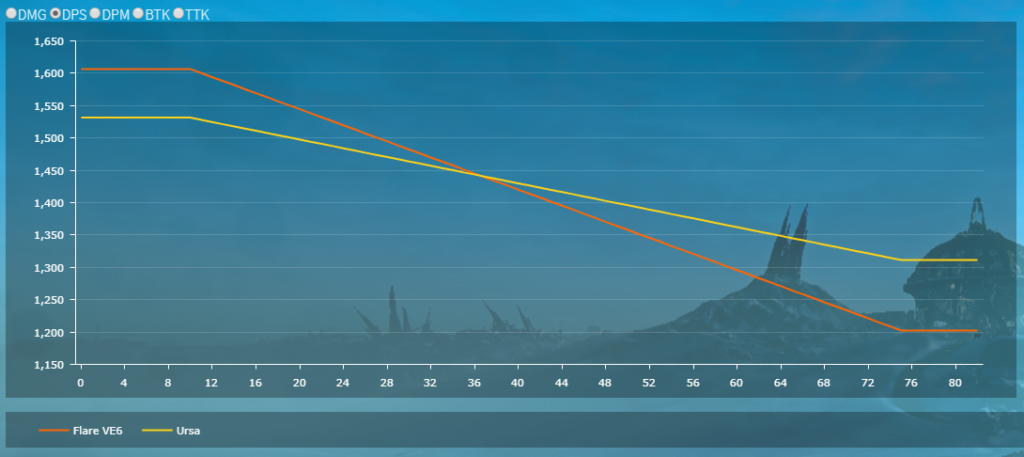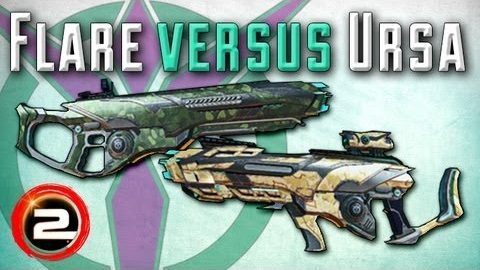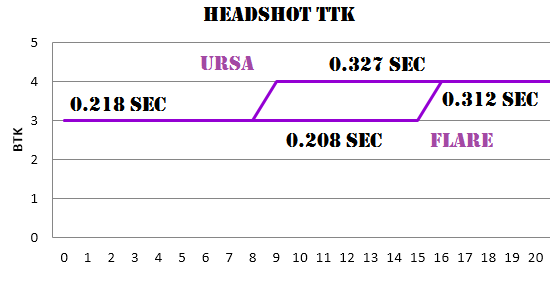Note: thumbnail image is shamelessly stolen from Wrel’s video comparison review.
Flare VE6 and Ursa are two very similar VS LMGs, and they often get compared to each other. Flare is rated higher by the community than Ursa, so let’s take a closer look and try to figure out why.
Stats
Flare |
Ursa |
|
| DAMAGE | 167 @ 10m – 125 @ 75m | 167 @ 10m – 143 @ 75m |
| FIRERATE | 577 RPM | 550 RPM |
| VELOCITY | 600 m/s | 640 m/s |
| AMMO | 75 / 300 | 75 / 300 |
| RELOAD | 4.24 sec / 5.225 sec | 3.72 sec / 4.7 sec |
| ADS ACCURACY | 0.03 / 0.2 / 0.03 / 0.4 / 0.06 | 0.03 / 0.2 / 0.03 / 0.35 / 0.06 |
| VERTICAL RECOIL | 0.4 | 0.395 |
| VERTICAL RECOIL PER SECOND | 3.847 | 3.621 |
| FSRM | 1.85x (0.74) | 1.5x (0.59) |
| RECOIL ANGLE | 0 / 0 | 0 / 0 |
| HORIZONTAL RECOIL | 0.2 / 0.2 | 0.182 / 0.182 |
| HORIZONTAL RECOIL TOLERANCE | 0.6 | 0.5 |
| AVERAGE HORIZONTAL DEVIATION | 0.165 | 0.149 |
| MAXIMUM HORIZONTAL DEVIATION | 0.4 | 0.364 |
Attachments
Common: Flash Suppressor, Suppressor, Forward Grip, Laser Sight, Darklight Flashlight, High Velocity Ammunition, Extended Magazine, Compensator.
Only Flare: Soft Point Ammunition.
Common Stats
| HIP ACCURACY | 3.25 / 3.75 / 3.75 / 4.25 / 0.12 |
| HEADSHOT MULTIPLIER | 2x |
| FIRE DETECT RANGE | 50m |
| ADS MOVEMENT MULTIPLIER | 0.5x |
| EQUIP / UNEQUIP TIME | 0.9 sec / 0.25 sec |
| ADS TO / FROM | 0.15 sec |
| PROJECTILE LIFESPAN / GRAVITY | 1.25 sec / 0 |
| RECOIL RECOVERY RATE | 13 |
| RECOIL RECOVERY DELAY | EQUAL TO REFIRE TIME |
Analysis
Ursa has:
- ~10% lower Horizontal Deviation
- ~20% lower First Shot Recoil
- ~6% higher Projectile Velocity
- Lower Rate of Fire results in ~6% less Vertical Recoil per Second
- ~12% faster Short Reload and ~10% faster Long Reload.
- 0.05 degrees tighter ADS Moving CoF
Nothing major so far, but better is better.
The biggest differences between these weapons lie in their damage properties.
Ursa has one tier higher Minimum Damage, which results in dealing up to 14.4% damage per shot, which happens at 75m.
Flare has ~5% higher Rate of Fire, which results in up to 5% higher Damage per Second within maximum damage range: 1606 vs 1531.
Ranged Performance

| DPS Overtake | Damage per Shot Overtake | |
| Flare vs Ursa | 37m | 14m |
| Flare SPA vs Ursa | 44m | 23m |
| Flare SPA vs Ursa HVA | 37m | 21m |
Due to higher Minimum Damage, Ursa starts dealing more damage per shot than Flare fairly soon. However, Flare has higher Rate of Fire, so it takes a bit longer for Ursa to catch up in terms of DPS.
- Ursa deals up to ~13% higher DPS than Flare at 75m.
- And Flare deals up to ~5% higher DPS within 15m.
Of course, Ursa will always be more effective at range due to better recoil. However, Ursa’s recoil advantage is fairly small. It seems that at least in terms of raw DPS, Flare can hold its own within ~40m, the range where most of the “useful” combat happens.
In long ranged combat, TTK usually rises to the point where you can often hide in cover if you are caught in an unfavorable position, and in situations like that needing an extra bullet to kill is not a big deal.
Flare’s performance at range is worse than Ursa’s, but that will rarely get you killed.
CQC Performance
Flare has ~5% higher Rate of Fire, so in situations when Bullets-to-Kill are equal, it will also have 5% shorter TTK. Same as with Ursa’s recoil, it’s not much of an advantage, but better is better.
However, only Flare has access to SPA, which is a sizable advantage, in this case.
167 damage weapons kill standard infantry in 3 headshots within their Maximum Damage Range, and SPA extends it to 15m. In terms of ADS performance in CQC, Flare is not very different from LA1 Anchor, which is considered to be one of the best LMGs in the game. In fact, Flare has less Vertical Recoil per Shot and lower First Shot Recoil than Anchor, so it can be more convenient, as far as landing headshots goes.
Of course, Anchor has other advantages, such as higher RoF and better Hip Fire, so we won’t focus on this.
SPA also helps Flare to somewhat compensate for dealing less damage per shot at range than Ursa. To gain a DPS advantage over Flare sooner, Ursa has to use HVA, which reduces its Maximum Damage Range to 8m, further increasing the gap between the two weapons.
Thanks to differences in Damage Ranges and Rate of Fire, Flare will hold up to ~57% advantage in headshot Time-to-Kill against standard infantry in the range bracket between 8m and 15m, which happens to be a fairly popular fighting distance.
Of course, SPA won’t always make a difference. For example, it makes no difference against Heavy Assaults with overshields, both with headshots and bodyshots – provided they are at full health and energy.
SPA won’t make a difference if the enemy has Nanoweave, and you’re going for bodyshots.
But it still should be well enough to make Flare a better choice for an average player, unless you specifically plan to participate in ranged combat.
In-game Performance

These are average stats of top 500 players with Ursa and Flare, taken from the Das Anfall’s leaderboards.
It’s interesting to note how close these two weapons are. Ursa does have a small advantage in terms of Accuracy and Headshot Kill Rate (HSR) – courtesy of the weapon’s better recoil.
Ursa also has lower LPK – shots Landed-per-Kill, obviously due to higher damage per shot.
Flare has an obvious advantage in terms of KDR. Though you can see the difference between KDR provided by the website, and the number that you get if you actually divide Kills by Deaths. On this picture, it’s marked as WKDR.
I’m not sure how to treat this disparity, but either way it’s pretty obvious that wielding Ursa gets players killed more than Flare.
Conclusion
Ursa is clearly better at range, but in current PS2 meta, it’s not much of an advantage. There’s currently not much reason to wield a dedicated “ranged” LMG for an average player.
While Flare is not a particularly stellar CQC LMG, it is better in that role than Ursa, which makes it a superior choice overall.

